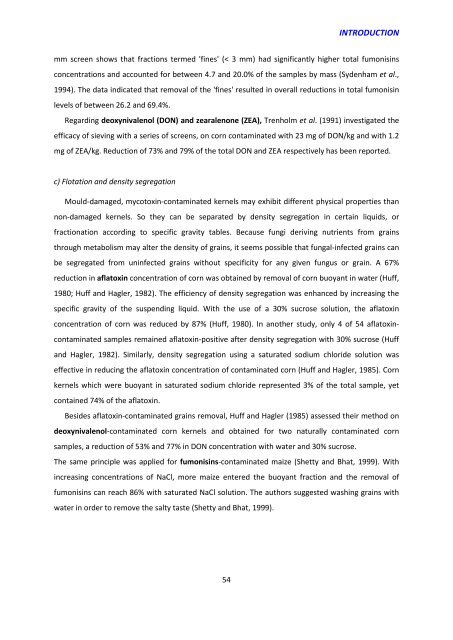Effet chez le porcelet d'une exposition à un régime co-contaminé en ...
Effet chez le porcelet d'une exposition à un régime co-contaminé en ...
Effet chez le porcelet d'une exposition à un régime co-contaminé en ...
You also want an ePaper? Increase the reach of your titles
YUMPU automatically turns print PDFs into web optimized ePapers that Google loves.
INTRODUCTIONmm scre<strong>en</strong> shows that fractions termed 'fines' (< 3 mm) had significantly higher total fumonisins<strong>co</strong>nc<strong>en</strong>trations and ac<strong>co</strong><strong>un</strong>ted for betwe<strong>en</strong> 4.7 and 20.0% of the samp<strong>le</strong>s by mass (Syd<strong>en</strong>ham et al.,1994). The data indicated that removal of the 'fines' resulted in overall reductions in total fumonisin<strong>le</strong>vels of betwe<strong>en</strong> 26.2 and 69.4%.Regarding deoxyniva<strong>le</strong>nol (DON) and zeara<strong>le</strong>none (ZEA), Tr<strong>en</strong>holm et al. (1991) investigated theefficacy of sieving with a series of scre<strong>en</strong>s, on <strong>co</strong>rn <strong>co</strong>ntaminated with 23 mg of DON/kg and with 1.2mg of ZEA/kg. Reduction of 73% and 79% of the total DON and ZEA respectively has be<strong>en</strong> reported.c) Flotation and d<strong>en</strong>sity segregationMould-damaged, my<strong>co</strong>toxin-<strong>co</strong>ntaminated kernels may exhibit differ<strong>en</strong>t physical properties thannon-damaged kernels. So they can be separated by d<strong>en</strong>sity segregation in certain liquids, orfractionation ac<strong>co</strong>rding to specific gravity tab<strong>le</strong>s. Because f<strong>un</strong>gi deriving nutri<strong>en</strong>ts from grainsthrough metabolism may alter the d<strong>en</strong>sity of grains, it seems possib<strong>le</strong> that f<strong>un</strong>gal-infected grains canbe segregated from <strong>un</strong>infected grains without specificity for any giv<strong>en</strong> f<strong>un</strong>gus or grain. A 67%reduction in aflatoxin <strong>co</strong>nc<strong>en</strong>tration of <strong>co</strong>rn was obtained by removal of <strong>co</strong>rn buoyant in water (Huff,1980; Huff and Hag<strong>le</strong>r, 1982). The effici<strong>en</strong>cy of d<strong>en</strong>sity segregation was <strong>en</strong>hanced by increasing thespecific gravity of the susp<strong>en</strong>ding liquid. With the use of a 30% sucrose solution, the aflatoxin<strong>co</strong>nc<strong>en</strong>tration of <strong>co</strong>rn was reduced by 87% (Huff, 1980). In another study, only 4 of 54 aflatoxin<strong>co</strong>ntaminatedsamp<strong>le</strong>s remained aflatoxin-positive after d<strong>en</strong>sity segregation with 30% sucrose (Huffand Hag<strong>le</strong>r, 1982). Similarly, d<strong>en</strong>sity segregation using a saturated sodium chloride solution waseffective in reducing the aflatoxin <strong>co</strong>nc<strong>en</strong>tration of <strong>co</strong>ntaminated <strong>co</strong>rn (Huff and Hag<strong>le</strong>r, 1985). Cornkernels which were buoyant in saturated sodium chloride repres<strong>en</strong>ted 3% of the total samp<strong>le</strong>, yet<strong>co</strong>ntained 74% of the aflatoxin.Besides aflatoxin-<strong>co</strong>ntaminated grains removal, Huff and Hag<strong>le</strong>r (1985) assessed their method ondeoxyniva<strong>le</strong>nol-<strong>co</strong>ntaminated <strong>co</strong>rn kernels and obtained for two naturally <strong>co</strong>ntaminated <strong>co</strong>rnsamp<strong>le</strong>s, a reduction of 53% and 77% in DON <strong>co</strong>nc<strong>en</strong>tration with water and 30% sucrose.The same princip<strong>le</strong> was applied for fumonisins-<strong>co</strong>ntaminated maize (Shetty and Bhat, 1999). Withincreasing <strong>co</strong>nc<strong>en</strong>trations of NaCl, more maize <strong>en</strong>tered the buoyant fraction and the removal offumonisins can reach 86% with saturated NaCl solution. The authors suggested washing grains withwater in order to remove the salty taste (Shetty and Bhat, 1999).54

















